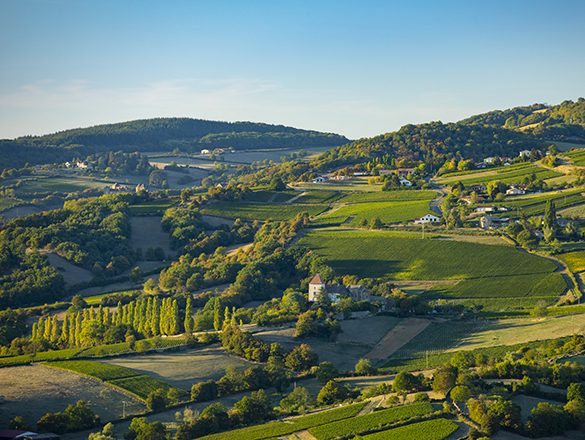
The vineyards of Bourgogne produce some great wines with a historical and international reputation. However, the region is not simply limited to its iconic appellations. In addition to its Village Premier Cru and Grand Cru AOCs, it also produces a range of wonderful Régionale and Village appellations to explore.
You will also find a full list of the Bourgogne’s Climats and lieux-dits on this page.
Check out the complete list of the 84 Bourgogne appellations.
However, your exploration has only just begun. Bourgogne wines have never before offered such high quality. Besides our range of internationally celebrated wines, try some of our lesser-known appellations where there are lots of surprises in store.
And for a fun way to find out more about the wines on offer, try out our “Which Bourgogne wine is right for me?” quiz, or check out Bourgogne Maps to take an interactive tour of the region.
Regional Appellation
VIGNOBLE DU MÂCONNAIS
31 juillet 1937
White: Chardonnay
Red and rosé: Gamay
Area under vine:
White: 46 hectares
Red: 9 hectares
Rosé: 0.4 hectares
Note: Average over three years 2016-2018
An additional geographical denomination that is part of the Régionale Mâcon appellation in the Mâconnais. According to the 2005 specifications rules, the name Mâcon-Milly-Lamartine refers to white, red, and rosé wines grown within a defined area in the villages of Berzé-la-Ville, Berzé-le-Chatel, Milly-Lamartine, and Sologny.

Mâcon-Milly-Lamartine whites have nuanced profiles reflecting the diversity of the terroir. Often with a dazzling golden yellow color, the nose can be very flattering or even sunny, thanks to its aromatic generosity that mingles aromas of yellow-fleshed fruit like apricots and peaches, combined with a few tropical touches of mango. In the mouth, they feel like structured wines, with body and volume, counterbalanced by a fairly lively finish.
A very intense garnet color, Mâcon-Milly-Lamartine wines produced from the Gamay grape offer indulgent flavors of red and black berries, like crushed strawberry, cherry, and blueberry, combined with floral peony aromas. Velvety in the mouth thanks to some very smooth tannins, the finish is crisp with a touch of spice.

White: With its sunny aromatic character and smoothness on the tongue, this wine makes a natural pairing with all kinds of goat cheeses, such as the traditional AOC Mâconnais or its neighboring Charolais for a terroir-themed aperitif. Follow with grilled chicken supremes or mixed fried river fish. This white wine will also bring out the best in local freshwater fish dishes, such as Dombes carp with white wine, or pochouse from Verdun-sur-le-Doubs.
Serving temperatures: 10-11°C as an aperitif, 11-12°C with food
Red: With its aromatic opulence and fleshy mouth, this wine is a remarkable companion with more fibrous meat dishes such as duck ravioli or braised côte de bœuf. For wine-marinated dishes, choose a hot year such as 2018, which will help soften the acidity of the sauce in a bœuf bourguignon or a snail meurette. To finish a meal, try a local washed-rind cow’s milk cheese that’s not too old, or something drier like a Palet de Bourgogne or a Cendré de Vergy, to match the freshness of the Gamay.
Serving temperature: 14-15°C

Located to the west of the longest limestone range, stretching from Tournus in the north to Fuissé in the south, the vineyards of Milly-Lamartine are found on the last western slopes of the Mâconnais. Its southern end runs alongside the communal boundaries of the Mâcon-Pierreclos and Mâcon-Bussières appellation areas.
The poet, historian, politician, and village mayor in 1812, Lamartine profited from the village’s reputation in terms of winemaking. In turn, Milly took his name by official decree in 1902. Describing himself as a “great winemaker”, Lamartine devoted himself to his family estate.
Before him, Lamartine’s native land had been visited by the powerful Barons of Berzé-le-Châtel and the Abbot of Cluny, Hugh the Great, and the poet himself visited the Holy Land in 1832. He solemnly watered the Garden of Gethsemane with wine from Milly.

Around Milly-Lamartine and in Sologny, the vineyards under the influence of the cool breezes from the first hills of the Haut-Mâconnais sit at between 287 and 380 meters above sea level on slopes facing the rising sun. At the foot of Le Monsard, the vines facing northeast are at between 275 and 330 meters. Beyond the river Fil and the main communication axes, the most dispersed plots sit on the warmer slopes, facing southwest at Berzé-la-Ville, and due south near the chateau at Berzé-le Châtel, between the contour lines at 350-400 meters above sea level.
At the foot of Le Monsard (407 meters above sea level), La Roche Coche (456 meters above sea level) in Berzé-la-Ville and Berzé-le-Châtel, the dark gray marl soil is low in limestone, but rich in iron and fairly thick with clay, sprinkled with pebbly layers. In Sologny, the vines grow on Trias clay, dating back some 230 million years. To the west of Milly, the slopes of Mont Cras, at 506 meters above sea level, present the full range of marl-limestone soil from the Bathonian, dating back some 168 million years.
